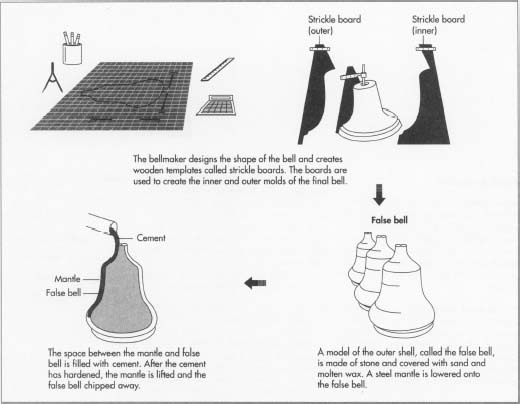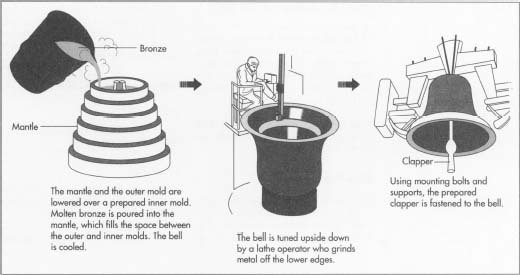Bell
Background
Since prehistoric times bells have been used to herald significant events. Bells call the faithful to worship and toll the time. The sound of a bell can express great joy, sound a warning, or signal mourning. Bells have also been rung to bring on or stop the rain, keep evil spirits at bay, invoke curses, and lift spells.
Bells hold an honored place in religious ceremonies. In both Buddhism and Christianity, bells are blessed before each ceremony. In Roman Catholicism, bells are symbols of paradise and the voice of God. The Russian Orthodox and the Chinese employ bells to speak to spirits or God.
Bells are also revered as patriotic symbols, and it was not unusual for invading conquerors to capture and silence the town bell. In the U.S., the great symbol of the American republic is the Liberty Bell.
The Chou Dynasty, which reigned in China from 1122 to 221 B.C. , was particularly known for its superior bell founding. European bell founding occurred much later and originated in medieval monasteries. The first European bells resembled cow bells: iron plates that had been hammered square and then riveted together. By the 15th century, founders began to experiment with bell shape and tone. Secular bellmakers gained prestige in the Renaissance with the flourishing of Gothic architecture which featured grand bell towers.
In the 17th century, Belgium and the Netherlands emerged as the leaders in bell founding. Dutch brothers Francois and Pierre Hemony are generally credited with developing the bell into a sophisticated musical instrument. The Hemonys worked with a blind musician named Jacob Van Eyck on a tuning system for the five separate and distinct tones contained in each bell's ring. After the deaths of Francois and Pierre and that of their star pupil, Caes Noorder, in the 18th century, the art suffered a decline. It was not until the 20th century that tuning techniques once again gained excellence.
Bell shapes vary by country and culture. The sides can be straight, convex, concave, or hemispherical. East Asian bells tend to be barrel-shaped while Western bells are tulip-shaped with a bulge near the rim. Chinese bells often have lotus-shaped rims. Bells of Western cultures are generally struck by an interior metal striker as the bell swings back and forth. Asian bells are non-swinging and are usually struck manually on the outside with a wooden mallet.
Raw Materials
While decorative bells can be made of such materials as horn, wood, glass, and clay, bells that are designed to ring or to play music are cast in a bronze alloy of approximately 77% copper and 23% tin. This combination produces a tough, long-lasting material that resists rusting. Bell founders must be careful not to mix in more than 25% tin or the bell will be brittle and susceptible to cracking. It is not unusual for old bells to be melted down and the metal re-used to cast new bells.
The Manufacturing
Process
The craft of casting bells has remained essentially the same since the 12th century.

Calculating the bell design
- 1 Using the specifications submitted by the purchaser, the bellmaker determines the shape that the bell will need to take in order to resonate with the proper number of vibrations. After estimating the required weight, the bellmaker orders the metal. These are painstaking measurements that can take several weeks of calculations to accomplish.
Making the bell pattern or template
- 2 The bellmaker cuts out two wooden templates called "strickle boards." One of the boards matches the dimensions of the outer bell (called the case or cope); the other matches that of the inner bell (called the core). These templates are used to construct the mold.
Constructing the mold
-
3 An exact stone model of the outer bell, sometimes called a false bell,
is covered first with sand or loam, then with molten wax. Figures and
inscriptions, also made of wax, are applied by hand. The false bell is
painted over with three coats of very fine, fireproof clay. It is then enclosed in a steel mantle that has been lowered by rope pulleys.

The space between the false bell and the mantle is filled with cement. After the cement has hardened, the mantle is lifted off the cement mold. The false bell, under the mold, is chipped away. Any remaining scraps of the false bell are removed with a blow torch. The mold is then set over a coke fire to melt the remaining wax and to evaporate any water that has accumulated.
A model of the inner bell is constructed of stone and coated with fireproof cement. It is then smoothed to remove any irregularities.
Casting the bell
-
4 After the mantle has been cleaned, it is again lowered over the outer
bell model. The mantle and the outer bell mold are then lowered over the
inner mold. The outer and inner sections are clamped together, leaving a
space between them, and set into a pit.
Ingots of bronze are melted in oil burners and heated to a temperature of approximately 1150°F (1100°C). The molten metal is skimmed to remove impurities and then poured into drums. The drums are carried to the pit and carefully tipped so that the hot metal flows into the space between the two molds. Holes in the top of the mantle allow gases to escape. If the gases remained in the metal, the bell would be too porous and easily cracked.
The bell is allowed to cool for several days. Large bells can take as much as a week to cool completely. Small bells, usually classified as those under 500 pounds (227 kg), can be removed from the molding pit the next day.
Tuning the bell
- 5 The bell is cast with slightly thicker sides so that the bell can be ground as it twirls slowly upside down on a circular lathe to acquire the precise tone. The bell tuner is highly skilled; it takes years of experience to know just how much metal to remove. The bell tone is tested frequently during the tuning process using an electronic device that registers the vibrations as the bell is struck. If the tone is too low, the lathe operator grinds more metal off the lower edge of the bell. If the tone is too high, the bell is thinned with a file.
Fitting the clapper into the bell
-
6 The clapper is manufactured in much the same manner as the bell
itself. Special care is given to cast the clapper at the proper weight.
A clapper that is too light-weight will not bring out the true tones of
the bell. A heavy clapper might cause the bell to crack.
Holes are drilled into the top of the bell. Using mounting bolts and supports, the clapper is fastened to the bell.
Quality Control
Great care is taken to calculate the precise weight and size of the bell before it is cast. If the finished bell does not meet specifications, it is completely melted down and recast. Should a bell crack at a future date, it might be welded and patched, but that is rare. The bell is more likely to be retired, as in the case of the Liberty Bell, or it is melted down and recast.
Where To Learn More
Book
Yolen, Jane. Ring Out! A Book of Bells. The Seabury Press, 1974.
Brochure
Royal Eijsbouts. Schulmerch Carillons, Inc., Carillon Hill, Sellersville, PA 18960, (215)257-2771.
— Mary F. McNulty
following can be true:
Ingots of bronze are melted in oil burners and heated to a temperature of approximately 1150°F (1100°C).
is correct.
P.S. Why doesn't your mailer like the name of that other copper alloy?